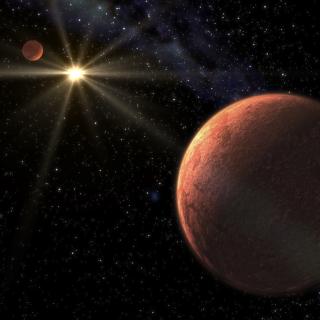Bibcode
Dreizler, S.; Luque, R.; Ribas, I.; Koseleva, V.; Ruh, H. L.; Nagel, E.; Pozuelos, F. J.; Zechmeister, M.; Reiners, A.; Caballero, J. A.; Amado, P. J.; Béjar, V. J. S.; Bean, J. L.; Brady, M.; Cifuentes, C.; Gillon, M.; Hatzes, A. P.; Henning, Th.; Kasper, D.; Montes, D.; Morales, J. C.; Murray, C. A.; Pallé, E.; Quirrenbach, A.; Seifahrt, A.; Schweitzer, A.; Stürmer, J.; Stefánsson, G.; Linares, J. I. Vico
Bibliographical reference
Astronomy and Astrophysics
Advertised on:
4
2024
Journal
Citations
14
Refereed citations
11
Description
The two known planets in the planetary system of Teegarden's Star are among the most Earth-like exoplanets currently known. Revisiting this nearby planetary system with two planets in the habitable zone aims at a more complete census of planets around very low-mass stars. A significant number of new radial velocity measurements from CARMENES, ESPRESSO, MAROON-X, and HPF, as well as photometry from TESS motivated a deeper search for additional planets. We confirm and refine the orbital parameters of the two know planets Teegarden's Star b and c. We also report the detection of a third planet d with an orbital period of 26.13 ± 0.04 days and a minimum mass of 0.82 ± 0.17 M⊕. A signal at 96 days is attributed to the stellar rotation period. The interpretation of a signal at 172 days remains open. The TESS data exclude transiting short-period planets down to about half an Earth radius. We compare the planetary system architecture of very low-mass stars. In the currently known configuration, the planetary system of Teegarden's star is dynamically quite different from that of TRAPPIST-1, which is more compact, but dynamically similar to others such as GJ 1002.
Full Table A.1 is available at the CDS via anonymous ftp to cdsarc.cds.unistra.fr (ftp://130.79.128.5) or via https://cdsarc.cds.unistra.fr/viz-bin/cat/J/A+A/684/A117
Based on observations collected at the European Southern Observatory under ESO programme(s) 0103.C-0152(A).
Related projects

Very Low Mass Stars, Brown Dwarfs and Planets
Our goal is to study the processes that lead to the formation of low mass stars, brown dwarfs and planets and to characterize the physical properties of these objects in various evolutionary stages. Low mass stars and brown dwarfs are likely the most numerous type of objects in our Galaxy but due to their low intrinsic luminosity they are not so
Rafael
Rebolo López

Exoplanets and Astrobiology
The search for life in the universe has been driven by recent discoveries of planets around other stars (known as exoplanets), becoming one of the most active fields in modern astrophysics. The growing number of new exoplanets discovered in recent years and the recent advance on the study of their atmospheres are not only providing new valuable
Enric
Pallé Bago